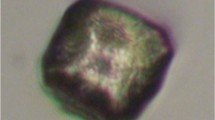Abstract
The classification of honey pollen grains is performed in order to classify honey according to its botanical origin, which is of great importance in terms of marketing. This visual work is currently done by human specialists counting and classifying the pollen grains in microscopic images. This is a hard, time-consuming, and subject to observer variability task. Thus, automated methods are required to overcome the limitations of the conventional procedure. This paper deals with the automatic classification of honey pollens using five representative Neural Networks coming from the ImageNet Challenge: VGG16, VGG19, ResNet50, InceptionV3 and Xception. The ground truth is composed of 9983 samples of 16 different types of pollens corresponding to citrus and rosemary pollens and its companions. The best result was obtained with the InceptionV3 network, achieving an accuracy of 98.15%, that outperforms the results obtained in previous works.
Access this chapter
Tax calculation will be finalised at checkout
Purchases are for personal use only
Similar content being viewed by others
References
Stillmana, E., Flenley, J.R.: The needs and prospects for automation in palynology. Quatern. Sci. Rev. 15, 1–5 (1996)
Holt, K.A., Bennett, K.D.: Principles and methods for automated palynology. New Phytol. 203(3), 735–742 (2014)
Sevillano, V., Aznarte, J.L.: Improving classification of pollen grain images of the POLEN23E dataset through three different applications of deep learning convolutional neural networks. PLOS ONE 13(9) (2018)
Sevillano, V., Holt, K., Aznarte, J.L.: Precise automatic classification of 46 different pollen types with convolutional neural networks. PLoS ONE 15(6) (2020)
Daood, A., Ribeiro, E., Bush, M.: Pollen grain recognition using deep learning. In: Bebis, G., et al. (eds.) ISVC 2016. LNCS, vol. 10072, pp. 321–330. Springer, Cham (2016). https://doi.org/10.1007/978-3-319-50835-1_30
Daood, A., Ribeiro, E., Bush, M.: Sequential recognition of pollen grain Z-stacks by combining CNN and RNN. In: The Thirty-First International Flairs Conference (2018)
Khanzhina, N., Putin, E., Filchenkov, A., Zamyatina, E.: Pollen grain recognition using convolutional neural network. In: 2018 proceedings of European Symposium on Artificial Neural Networks, Computational Intelligence and Machine Learning (ESANN 2018), Bruges (Belgium), pp. 25–27 (2018)
Astolfi, G., et al.: POLLEN73S: an image dataset for pollen grains classification. Eco. Inform. 60, 101156 (2020)
Tsiknakis, N., et al.: Pollen grain classification based on ensemble transfer learning on the cretan pollen dataset. Plants 11(7) (2022)
Feng, V.: An Overview of ResNet and its Variants (2017). https://towardsdatascience.com/an-overview-of-resnet-and-its-variants-5281e2f56035
Szegedy, C., Vanhoucke, V., Ioffe, S., Shlens, J., Wojna, Z.: Rethinking the Inception Architecture for Computer Vision (2015). https://arxiv.org/abs/1512.00567
Chollet, F.: Xception: Deep Learning with Depthwise Separable Convolutions (2016). https://arxiv.org/abs/1610.02357
Simonyan, K., Zisserman, A.: University of Oxford: Very Deep Convolutional Networks for Large-Scale Image Recognition (2014). https://arxiv.org/abs/1409.1556
Acknowledgment
This work is part of the project PID2019-106800RB-I00 (2019) of the Ministry of Science and Innovation (MCIN), State Research Agency MCIN/AEI/https://doi.org/10.13039/501100011033/. It is also part of the AGROALNEXT/2022/043 project, financed by the Generalitat Valenciana, the Next Generation European Union and the Recovery, Transformation and Resilience Plan of the Government of Spain.
Author information
Authors and Affiliations
Corresponding author
Editor information
Editors and Affiliations
Rights and permissions
Copyright information
© 2023 The Author(s), under exclusive license to Springer Nature Switzerland AG
About this paper
Cite this paper
López-García, F. et al. (2023). Classification of Honey Pollens with ImageNet Neural Networks. In: Tsapatsoulis, N., et al. Computer Analysis of Images and Patterns. CAIP 2023. Lecture Notes in Computer Science, vol 14185. Springer, Cham. https://doi.org/10.1007/978-3-031-44240-7_19
Download citation
DOI: https://doi.org/10.1007/978-3-031-44240-7_19
Published:
Publisher Name: Springer, Cham
Print ISBN: 978-3-031-44239-1
Online ISBN: 978-3-031-44240-7
eBook Packages: Computer ScienceComputer Science (R0)




